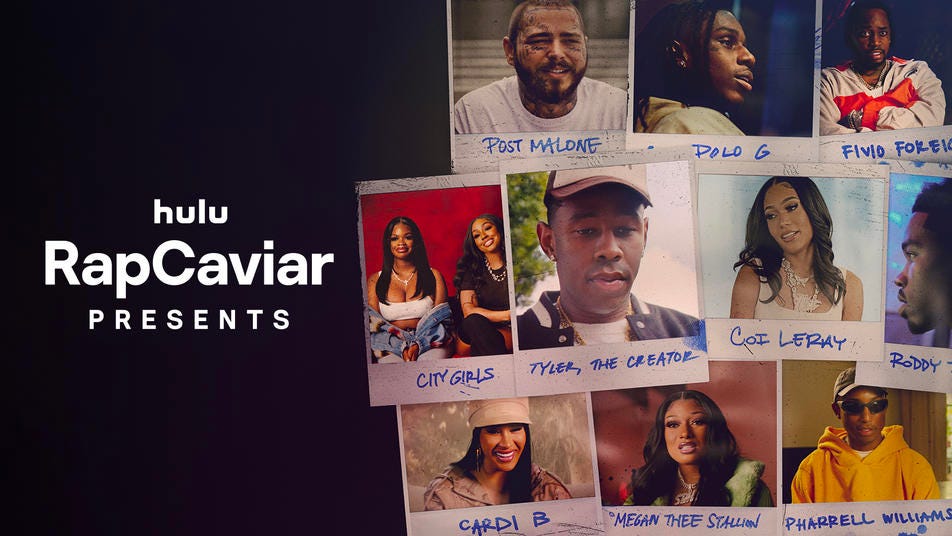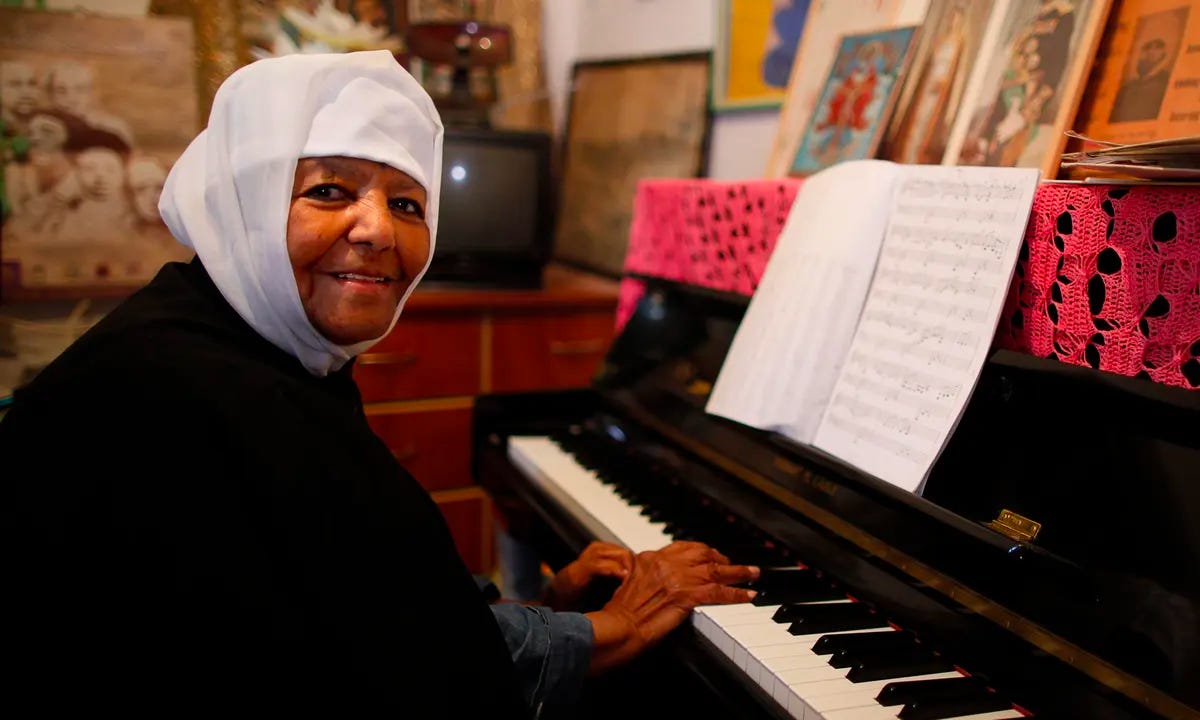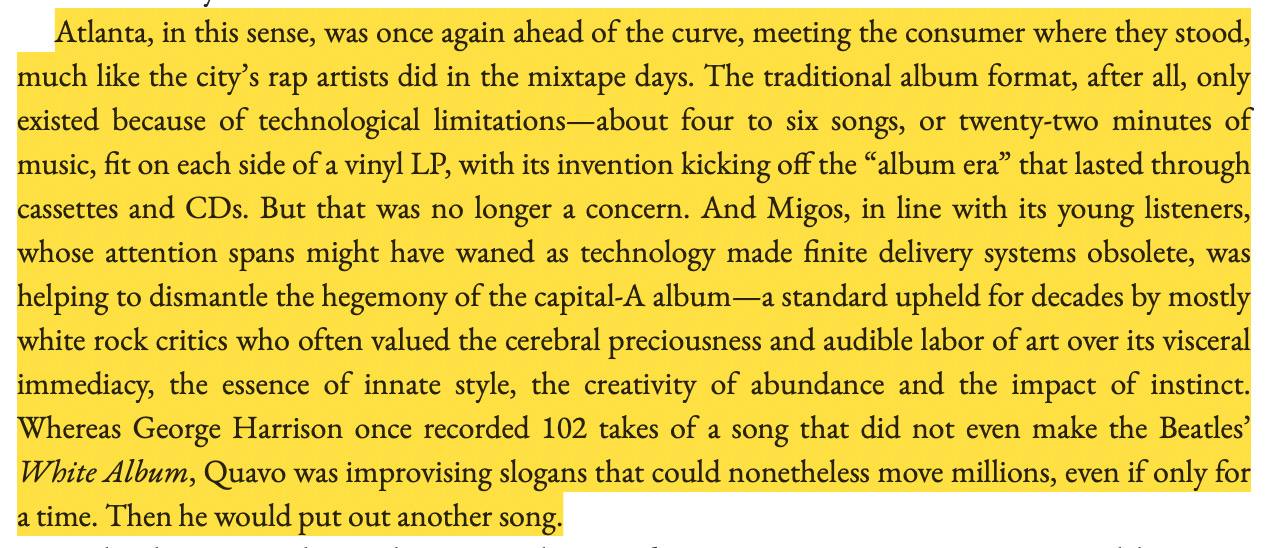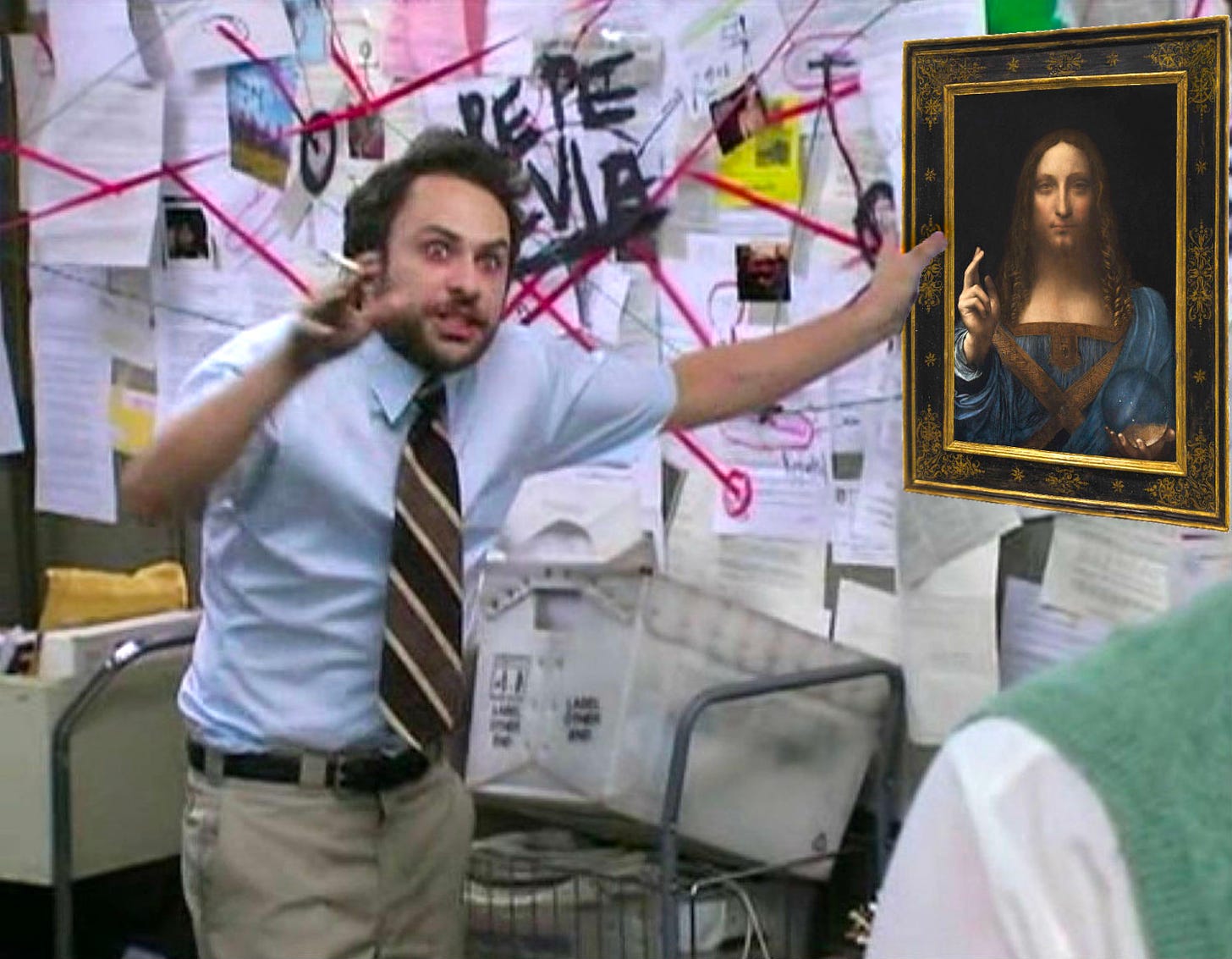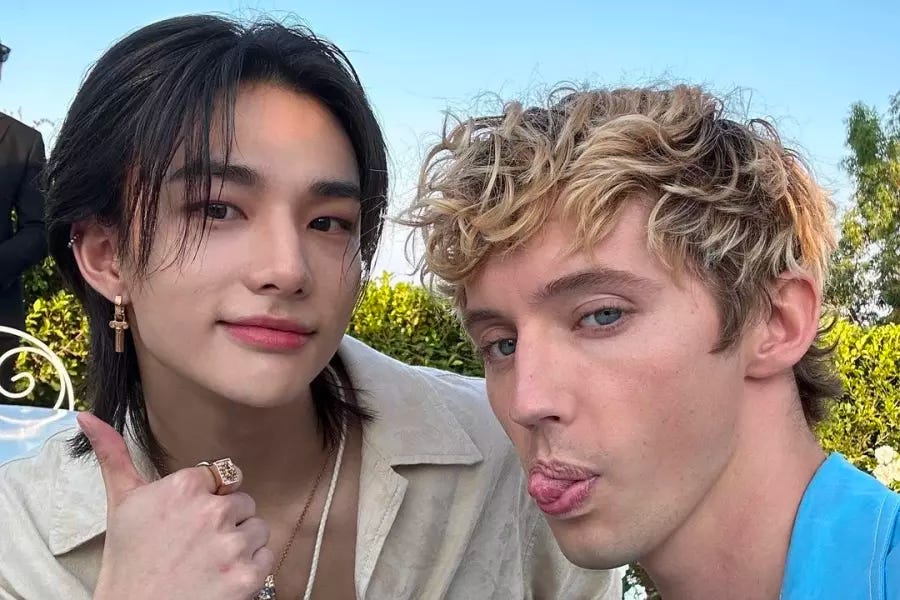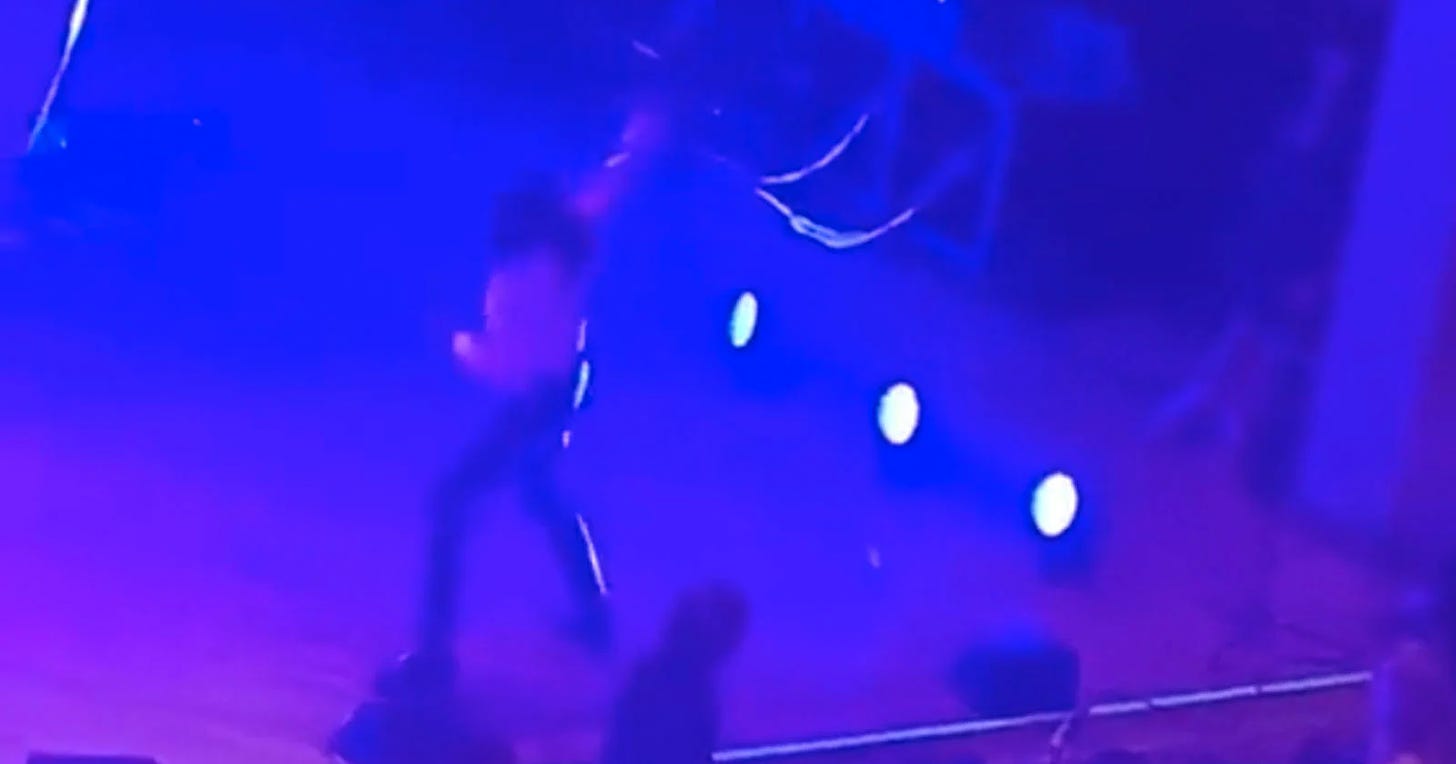Jun Takahashi, BORN, 2023
One of my first digital-native social experiences was in 2012 (I just barely fall outside of the age range to have been an AIM power user) on Spotify. I was in eighth grade and would send my LDR crush (he went to a different local middle school) song recommendations through the inbox feature; the feature was later removed in 2017, and quickly forgotten. But one of my friends has a theory: “They definitely got rid of DMs so they can funnel you to the curated playlists… that’s where they make money.”
I remain skeptical about the theory, but it at least has legs. Spotify-curated playlists like Pollen and RapCaviar have attracted tens of millions of followers. Before TikTok became a launchpad for music discovery, snatching a spot on one of these coveted playlists was a test of an artist’s ability to penetrate the mainstream. RapCaviar now has its own TV documentary mini series on Hulu. Spotify is even credited for coining the term “Hyperpop,” for better or for worse.
While it’s common knowledge that music discovery has become more algorithmic and less social, the full complexities of this shift remain unseen. Every day continues to generate new questions about how we engage with music and media at-large.
The Era of Streaming + Power Law
The value of an individual song listen is less than it used to be, largely thanks to all-access streaming subscriptions. Streaming accounts for more than 80% of total recorded music revenues in the U.S., and Spotify has over 30% market share of the global music streaming market (probably even higher in the U.S.).
Not only are users today not buying music, streaming royalties are also arguably just broken. To give a simplified overview of how Spotify pays royalties, Spotify sums the total number of monthly streams on the platform and self-reportedly pays 70% of subscription and ad revenues out to rightsholders (distributors, labels, etc.) based on their proportions of overall streams for the month. Artists are then paid by the licensor based on their respective contracts. The exact terms of an artist’s contract significantly impact how much that artist is ultimately paid from streaming.
With a typical record label, an artist may be paid an upfront advance that the label must recoup before it pays the artist any streaming royalties (usually 20-25%). Alternative distribution platforms like CD Baby offer options for independent artists such as a flat distribution fee ($9.99) + commission on streaming revenue (9%)—big s/o to Cherie from Water & Music for sharing these examples with me!
A few key observations to tease out here:
Spotify doesn’t pay artists directly, it pays rightsholders.
Spotify doesn’t pay royalties per-stream, but instead by “streamshare.”
This also has a few major implications:
Spotify’s pro rata model means the lion’s share of payouts will always go to the rightsholders with the most cumulative streams on the platform.
Spotify payouts mainly rely on flat, all-access subscription pricing that has only increased once in the past ten years.
This isn’t to say that streaming is all Bad. Platforms like Spotify democratize access to potential listeners and fans. Nearly 80% of artists on Spotify have fewer than fifty monthly listeners. I love this passage from an article by Ethan Iverson for The Nation:
“Music streaming has done a lot of good. The old industry was a classic gatekeeper, and only a chosen few got a chance. Now everyone has a shot. One example from my personal files: After I included a delightful track by the Ethiopian nun Emahoy Tsegué-Maryam Guèbrou on a Spotify playlist for The New York Times called ‘5 Minutes That Will Make You Love Piano,’ notes poured in from everywhere, including from fashion designer Isaac Mizrahi and artist Christoph Niemann. I’m not the only one who has been talking up Guèbrou in the past decade, and our push has apparently succeeded: I’ve heard Guèbrou in restaurants, in airports, and in the Netflix adaptation of the novel Passing. Guèbrou died this year at 99; I hope her late-in-life renaissance has secured her legacy. At any rate, it makes a difference that Guèbrou is only a click away on the streaming services.”
Based on today’s model, longtail artists will likely never be able to sustain their music careers from streaming revenue. Only 0.41% of UK artists are expected to make a sustainable living from streaming according to a report by the UK Intellectual Property Office. To be fair though, streaming is often not the highest revenue stream for most music artists. The majority of a music artist's revenue is typically made from experiential, direct-to-fan offerings like touring, merchandise, and paid memberships, and/or from higher-margin enterprise deals like brand sponsorships and TV/film syncs.
Big Algorithm + The Death of Social Discovery
Discovery, whether for new music or new brands, used to be deeply social. Tastes and trends were local and contextual. Radio and TV were the first infrastructural leaps to make discovery more broad, with the internet following suit. I was no longer confined to the tastes of my suburban hometown, I could go online and check out what the people of New York City were into–even if it’s just by watching a dancing NPC outside the SoHo Prada store.
Algorithmic feeds take this even further. Many of the platforms we consider “social” today aren’t even all that social… they’re also more broadcast-based (TikTok, YouTube, new Instagram, new Twitter). Broadcast and algorithmic platforms isolate you from local, social contexts so you rely more on your personal feed. Kyle Chayka writes more about this in a recent piece for The New Yorker, “Why the Internet Isn’t Fun Anymore.”
To bring this point back to music, prior to the birth of what I’ll call “Big Algorithm” was the maturation of its older sibling the “Attention Economy.” During this shift, shortform content became king. Music albums as monolithic projects started losing power. I wrote about this in a piece from August about subcultures, so I’ll simply rehash it here:
“The album as we know it is dead. While albums used to be singular projects with clear narrative arcs, new albums are more often collections of disparate singles with banger potential or they’re shorter EPs. Artists are even teasing songs on TikTok to see which ones are worth releasing. A group who noticed and capitalized on this early was Migos in the mid 2010s (RIP Takeoff).”
From Joe Coscarelli in Rap Capital:
If you squint just a little, these loose threads begin to appear intertwined.
People go online → the digital Attention Economy thrives → albums get shorter, individual tracks become the atomic unit → Big Algorithm springs up, individual songs gain even more power due to virality potential → the blinding speed of internet-native search and Big Algorithm means domination by instantaneous broadcast feeds.
Identity + Post-Criticism
You would think that if traditional social discovery is dead, centralized platforms for criticism and media would actually gain influence. People would need to look towards a mass center to find a social consensus for Taste. In reality, this seems…half true?
When records first became popular, music criticism was a core component of the music landscape. Before I spend time and money to buy a record, I should know if it’s good or not. Today, music is free. Post-record but pre-internet, music magazines broke artists, alerting listeners to who should be on their radars. Today, artists often break themselves–and not just through their music.
With the death of the capital-a Album, you optimistically have about 200 seconds to capture a listener’s attention with your music. In an era in which artists are discovered on “social” platforms, the focal points become the individuals themselves. Music artists who capitalize on this feature can experience major boosts in popularity.
Troye Sivan and Renee Rapp are artists who are known to be TikTok power users, and they have both experienced massive gains from it, creating hidden inside jokes with fans who religiously follow their feeds (Troye Sivan’s masterful “Rush” promotion, activating kpop stans through a Hyunjin fancam edit).
Another way to frame this shift is that art and media have become much more identity-centric.
Constructing identity–both as an artist and as an average listener–is complicated in a Big Algorithm society. I wrote earlier that broadcast and algorithmic feeds are isolating, but the method by which these platforms isolate you is not just by literally cutting you off from local content or discourse. Endless feeds and global search offer access to an infinite scroll of new contextual layers through which to view yourself. While then identity becomes more dynamic and fluid, finding platforms and communities that support these nuances becomes another challenge. Fashion commentator Bliss Foster describes this well in a video about subcultures:
“You could moderate a subreddit for the Canadian punk scene while posting every day to a dark web Death Grips forum while being a massive Twitter advocate for a Marxist political candidate in Alaska, all while watching 24-hour news coverage of Formula One racing. Then that same kid could get up, put on a Nike tracksuit, and go to their high school where they play football and never talk to their friends about their actual interests.”
Artists are finding their own identities and sounds with newfound complexity, powering rapidly emerging niche, often internet-native styles of music–”Plugg,” “Nightcore,” etc. Classifying new music today through legacy lenses like Rock or Hip-Hop is practically impossible, and new artists (see: Paris Texas, Jean Dawson) reject being placed into these boxes.
It’s hard to imagine how any single media institution can accurately survey the genre-sprawling music landscape of today. Smaller, vibrant platforms exist to fill the gap across media (No Bells), radio (NTS), and more–but the growth path or ideal end state for these operations is not entirely clear. UMG recently bought a stake in NTS. Even Boiler Room is owned by DICE, which has raised over $50M in venture funding.
In this paradigm, media platforms and criticism still matter, but in a totally different way.
Music journalists must transform into more general “culture journalists” if they hope to cover the full breadth of an artist's work and impact. Cultural commentary more often than not lives on platforms like TikTok, meaning artist coverage is driven by paid influencers and devoted stans who have developed parasocial loyalty to their favorite artists.
The artists themselves are also left to reckon with the question of who they would rather be engaging with and/or commenting on their music (see: Steve Lacy, Doja Cat).
From Ed Sheeran in an April 2023 Rolling Stone interview: “‘Why do you need to read a review? Listen to it. It's freely available! Make up your own mind. I would never read an album review and go, 'I'm not gonna listen to that now.’”
From Ice Spice in an October 2023 Complex cover story: “So, aside from the people in her corner, whose opinion does she care about? ‘The critics,’ she admits. ‘Because they actually study music and care about it. So I feel like I’d rather hear their opinion. I'm more interested in that because at least it’ll be paragraphs explaining why they feel that way and I'll be able to understand the person better versus just one little hateful ass comment from a private page. At least there's an author and a face attached.’”
The question of criticism’s role in the modern music landscape is existential and pressing; so pressing that the music media scene recently erupted in outrage upon hearing that Bandcamp’s editorial operation was shuttered by its most recent acquirer, Songtradr.
In a post-Criticism world, who assumes the role of the critic? The same handfuls of pedigreed writers who take turns writing for the same tens of major publications or TikTok stan journalists who film content in their bedrooms? In a post-Media world, where does discourse live? In the comments sections and Discord servers of the Fantanos-type commentators of the world or in stan forums like KTT?
The colloquial title of “curator” elevates the average listener to a more critic-like role, but even then curation in practice usually refers to general lifestyle aspiration, rather than any specific mode of knowledge.
What’s Next
The modes that we currently have for engaging with music–including everything from listening, to distributing, to discussing music–feel more outdated everyday.
It’d be silly of me to claim that I have solutions to the sprawling, deep-seated problems within the music industry and media at-large. Instead, I want to highlight a few popular solutions I’ve come across and some notes for consideration:
Why don’t we move to a user-centric payment model? The premise is simple. Instead of a pro rata model, streaming platforms pay royalties per-stream. For the user, that means your platform subscription fee goes towards the artists you actually listen to, rather than to a general pool. The popularity of the model has fluctuated over the past decade, making a resurgence more recently (driven mainly by UMG). Spotify, Tidal, and Apple Music have all at least entertained the idea in the past, while SoundCloud actually implemented it in 2021. The discussion is nuanced, but the high-level argument against a user-centric payment model is that it removes the regulatory burden of fair practice away from labels and platforms, and instead puts it on unregulated, generally less educated fans. In many cases, smaller artists’ revenue may actually be subsidized by that of larger artists belonging to the same label. Brilliant music writer David Turner has written about streaming payment models several times for his music business newsletter, Penny Fractions–the latest being “The Payment Model Debate Isn’t Over.”
Why don’t we enable fractional song ownership/streaming royalties for fans? Over the years, there have been several approaches to this type of platform spanning both Web2 (JKBX) and Web3 (Royal), but the general idea is that fans should be able to invest in songs by purchasing stakes of the royalty streams. For what it’s worth, I think the concept of music royalties as an alternative asset class is fine, but you’re not going to capture the attention of fans. And through an investing lens, the returns prospects of song royalties are highly debatable, especially considering the glaring fact I pointed out earlier that streaming doesn’t make most artists that much money anyway.
Music today exists in a landscape wildly different from the one of fifty or even only ten years ago. Streaming platforms like Spotify and social platforms like TikTok have completely upended the way music gets discovered, distributed, and monetized. While these platforms have done wonders to break and elevate new artists, they have stripped away many of the financial and social safeguards afforded to them by clear music ownership and pedestaled media platforms.
I’m of the firm belief that the platforms that ultimately best support artists will be the platforms that, whether directly or indirectly, put money in artists’ hands. However, a false assumption I often see in discourse around platform innovation is that the features must be explicitly financial (and often explicitly speculative) in order to create meaningful capital opportunities for artists. The design space for empowering artists is much bigger than designing purely financial primitives, which brings us back to the role of media and social discovery. Designing new social-first experiences for music discovery, discourse, and engagement is crucial in a time where users won’t pay for music, but they will pay for connection and experiences.
While what the exact future state of these platforms look like is unclear, here are few concepts I’m interested in:
Platforms that spotlight a track’s social provenance, highlighting its often unsung songwriters and producers, and create rich attribution graphs and experiences around those social connections.
Platforms that spotlight a track’s data provenance, gamifying remixing and experimental AI creation while preserving attribution and data provenance.
Decentralized media and curatorial platforms, where media is sustainably co-created and co-distributed by the local scenes and communities that create niche scenes and sounds.
Digiphysical platforms and experiences that sit at the interplay of live and digital.
If you’ve thought about any of these problems and/or just love music to your core, I’d love to jam with you.
I’ll be posting a more solution-oriented PT II soon. Stay tuned.
thank you to Cherie from Water & Music (go check it out!) for feedback and invaluable insights on the music industry and to Ruby, Anna, Reggie, and Sean for further review and feedback





